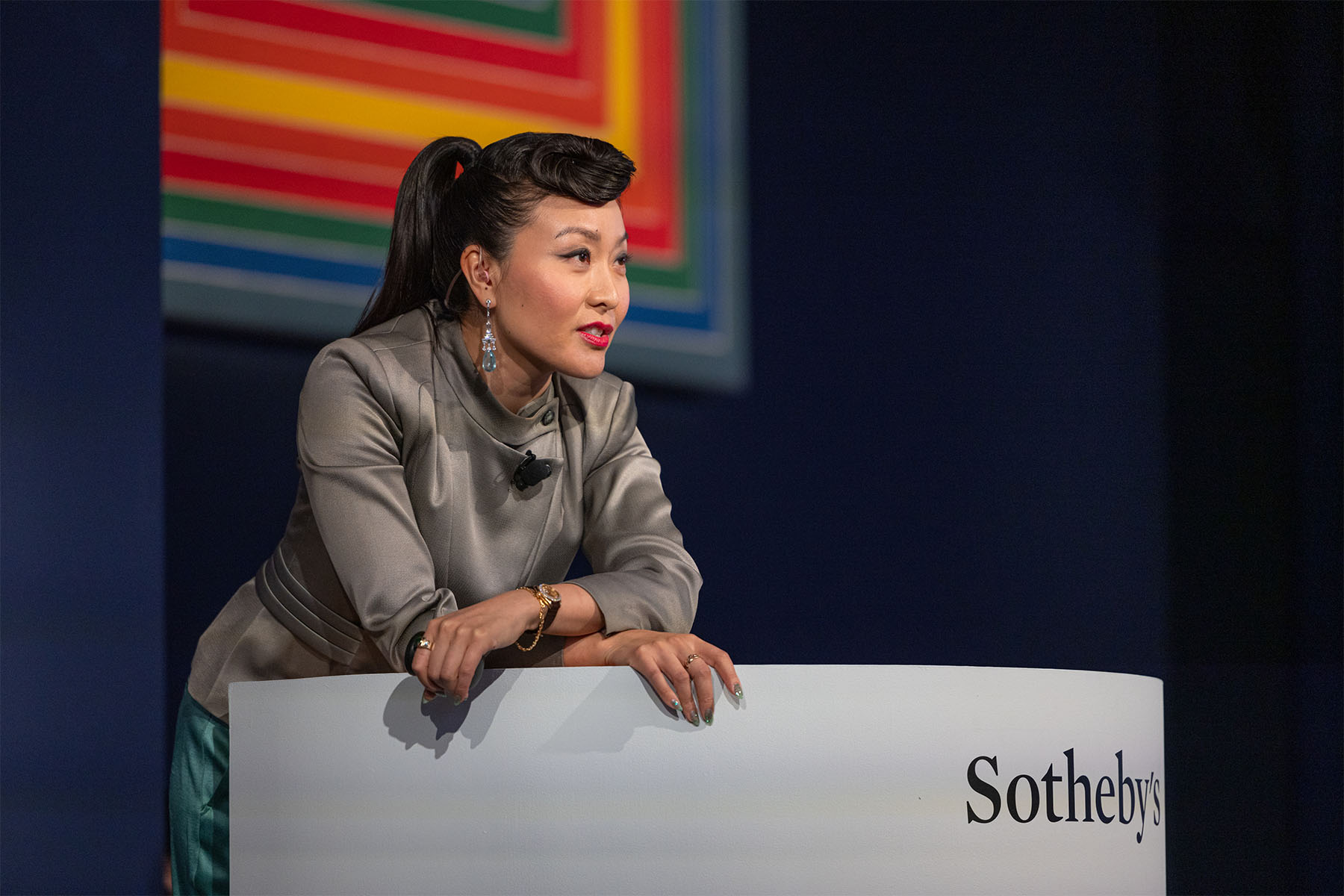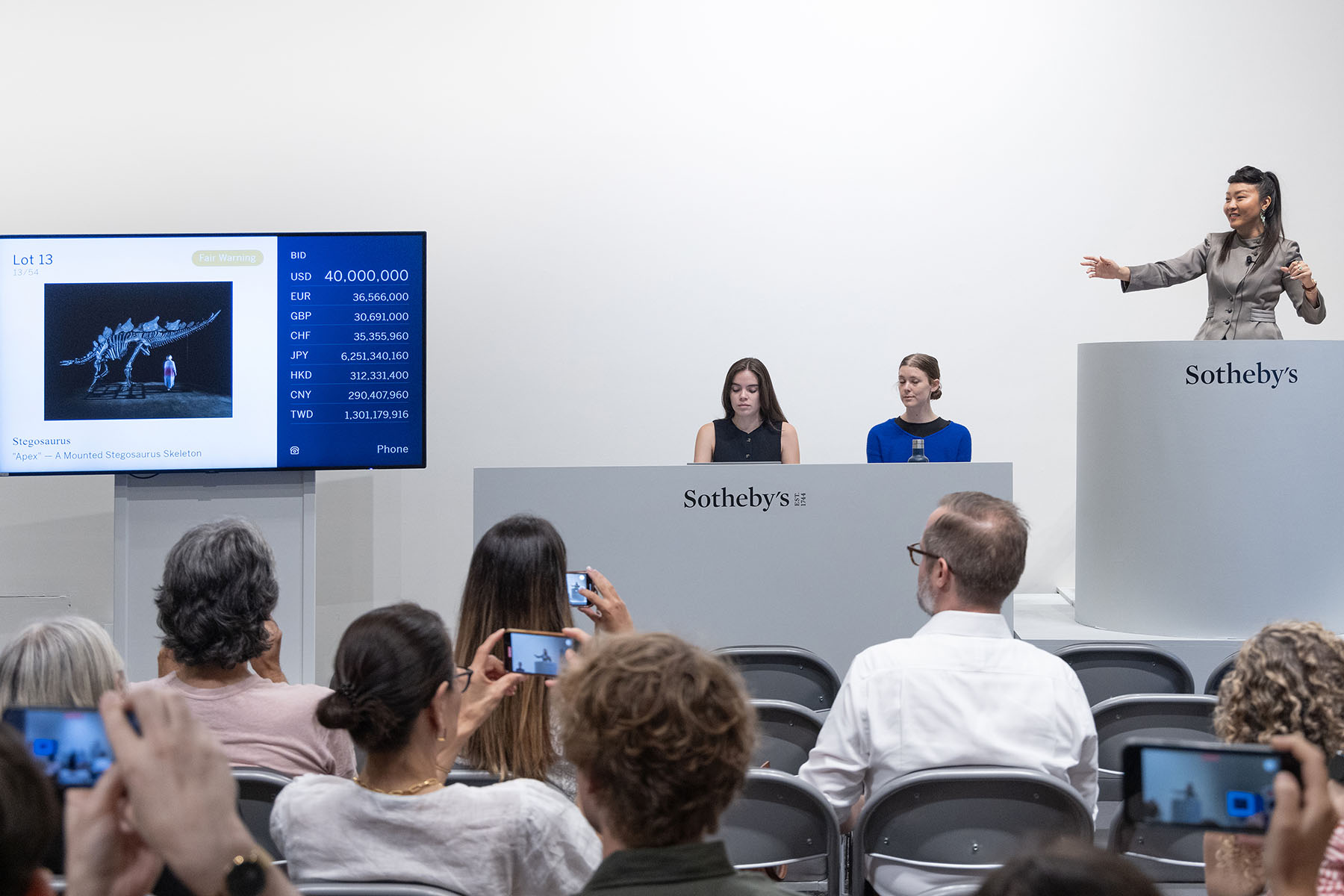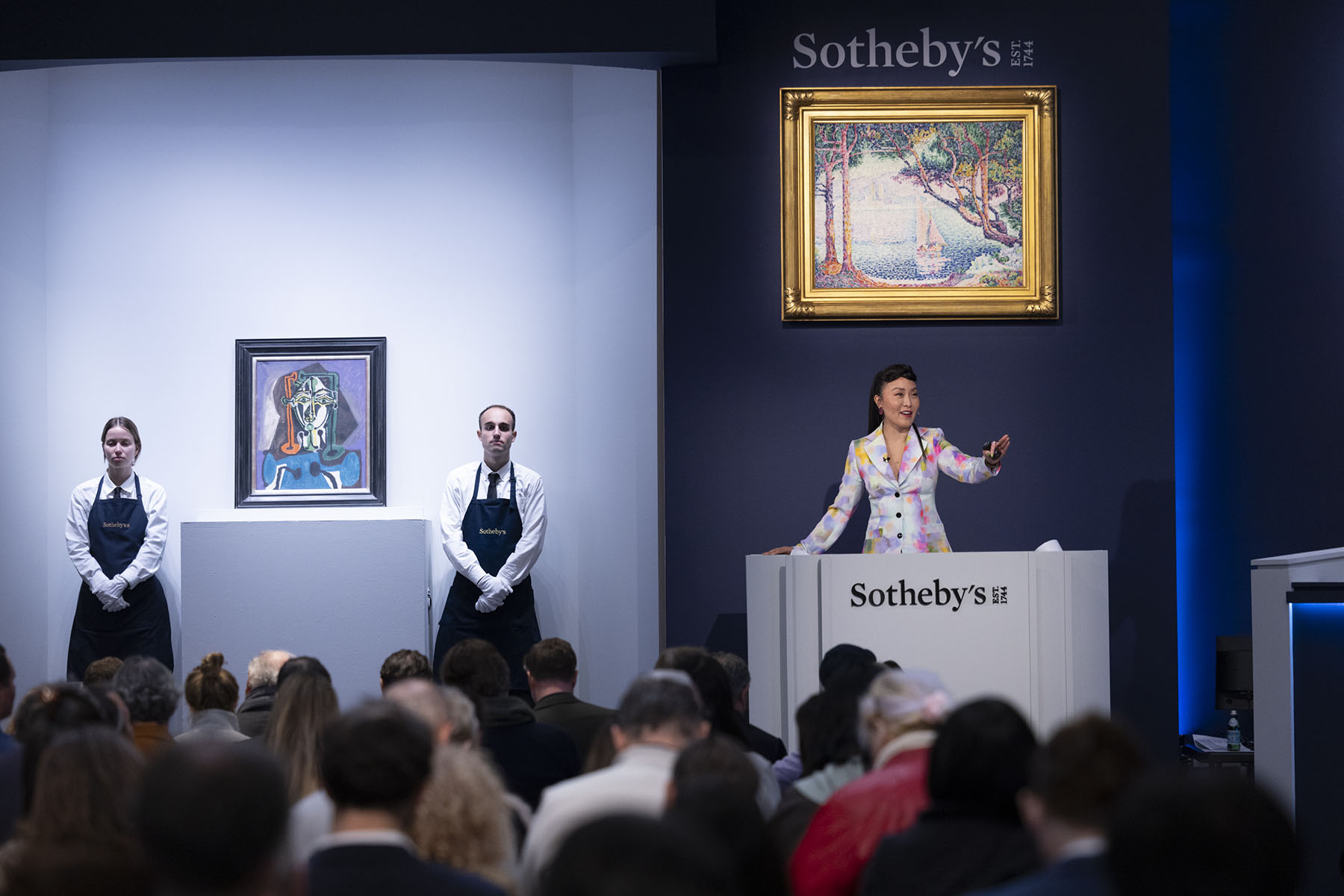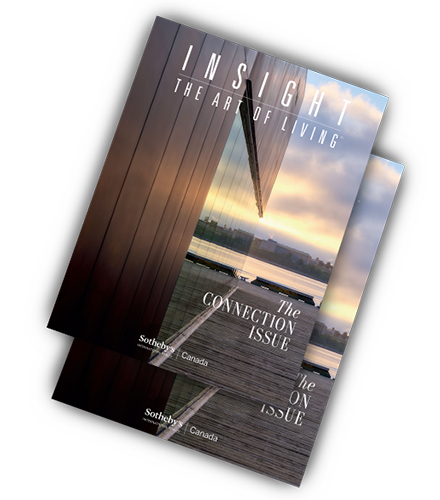It was the auction that reverberated throughout the world. Apex the Stegosaurus, a rare 161-million-yearold dinosaur skeleton, sold at Sotheby’s last July for a record-breaking US$44.6 million after an intense 15-minute bidding war. But it wasn’t just the fossil or its historic sale price (more than 11 times the estimate) that made waves — Sotheby’s auctioneer Phyllis Kao, as emcee, presided over it all. And her star-turn performance — streamed live online and on TikTok for millions of viewers — almost eclipsed the mammoth skeleton.

With her skillful display — a graceful wave of the hand, a coy smile, an engaged lean-in towards the audience — Kao courted phone bidders to raise their prices ever higher. Dressed in a tailored silver grey Armani suit jacket and sporting an elegant updo worthy of a 1940s film star, Kao maintained a calm and collected demeanour as she interjected with lighthearted comedic quips like “They’re just numbers at this point” or “Would you like to try a smaller bite?” The thrilling spectacle seemed effortless in Kao’s hands as she directed the flurry of bids until the final gavel smash and declaration that Apex was “Sold!” were met with rounds of applause.
Kao, a VP of client strategy at Sotheby’s in New York, became a social media sensation overnight, which admittedly surprised her. The video of the stegosaurus auction alone had more than 11 million TikTok views, other auction videos featuring Kao garner millions, and she has received heaps of praise from fans commenting that she is a “legend” and that “Phyllis Kao is an icon.”
“I don’t have TikTok, so I had no idea that was happening,” says Kao. “And I think it’s a blessing that I’m not keeping track of that. It’s not what I do. But I thought it was really interesting that the TikTok generation is taking such an interest in auctions. I think that’s very positive for our industry.”
While Sotheby’s live-streamed its auctions before the pandemic, its evening auctions — more formal affairs featuring rare, big-budget lots — have evolved into elaborate productions similar to “live TV,” according to Kao. These event-style presentations now reach millions online and on social media. Kao’s following highlights the essential performance aspect of auctioneering, something she likens to being an improvisational jazz performer. “An auction is not scripted, of course,” she says. “You don’t know what will happen. So, you have to improvise.”

Like many in her industry, Kao has a performing arts background. As a teenager she studied classical violin, something she thought she would pursue professionally. But she was also fascinated with art, spurred by her grandfather, who collected Chinese works. In college, Kao studied Chinese art and artifacts, with a focus on Buddhist art, which remains one of her favourites in the art world. “Tang dynasty, Buddhist sculpture, you just can’t get better than that,” she says.
Kao got her start in the auction world with a temporary role at a small auction house in the Bay Area, California, where she grew up. She had planned to further her education by studying classics at Columbia but was offered a full-time job as a cataloguer in decorative arts at the house, which had acquired a trove of Chinese artworks.
With no training, Kao hosted her first auction (or, in auction parlance, “took a sale”) at the age of 23 and, from then on, she was hooked. “I thought: Wait a minute. This is a job? You’re just spending other people’s money and looking at beautiful things for them,” she says. “And I liked the field. I liked the industry. Every day is different. You meet all sorts of people. You’re surprised daily by who you meet and what you find and I just kept working.”
From there, she went on to bigger and bigger auction houses and ultimately landed a role as a specialist in Chinese art at Sotheby’s in New York. While she’s been an auctioneer for over a decade, Kao had to audition to conduct sales. Kao nailed her audition, with one exception: her long hair kept hitting the microphone as she moved. Hugh Hildesley, head of auctioneers emeritus at Sotheby’s, asked that she wear her hair up so as not to distract from the presentation. Kao styled her hair in an elaborate updo for the second audition, with coils of hair framing her face. “It went off really well,” she recalls. “So, I started doing it for every sale. And it very quickly became my signature look.” Kao says she looks so different when wearing her auction hairstyle versus her dayto-day straight long hair that people often don’t recognize her on the street.
But preparing for an auction goes beyond mere style choices. For an all-important evening sale, for example, Kao has to know the works in question “inside and out,” which requires extensive research. Regardless of the type of sale she’s conducting — whether evening or day sales, which cross price points and categories, from wines to watches — Kao is meticulous about studying an item’s provenance and significance. “I want to understand why it’s a coveted work. And I want to be able to get into the psychology of my buyer as much as I can.”

She adds, “The role of an auctioneer is multifaceted. You are a master of ceremonies. You are a host or hostess, the face of the company. You are a salesman. You are a performer. It’s quite psychological and you have to stay on top of business decisions. There’s numbers and there’s a lot of quick thinking.”
Same as in liveTV, evening auction sales have a production crew on hand and a tech run-through ahead of the proceedings. “With that high production quality, there are a lot of people who watch auctions now who wouldn’t have before,” says Kao. “For an auctioneer, there’s more to keep track of because you’re [presenting] live to a bigger audience and there’s more pressure.” Kao’s background in performance has helped her stay grounded and connect with an audience by projecting confidence and presence. “When I was a violinist, I was on stage roughly every two weeks performing. Nothing can be as difficult as playing solo violin on stage. The performing arts background certainly helped give me strong nerves.” Still, to get in the proper mindset ahead of an all-important evening auction, Kao practices meditation to feel grounded.
And as for that stegosaurus, it was purchased by billionaire hedge-fund manager and collector Kenneth C. Griffin and is now on view at the American Museum of Natural History in New York for the next few years. The sale, though, will remain a career highlight for Kao. “That record will probably be tough to beat in terms of hammer price.”
While Chinese art will always hold a special place in her heart, Kao delights in the variety of artworks and precious items she encounters at Sotheby’s. “I do love it all. I’m thoroughly an auction person.”
By Kristen Vinakmens — *This article originally appeared in Insight: The Art Of Living Magazine – The Connection Issue.



